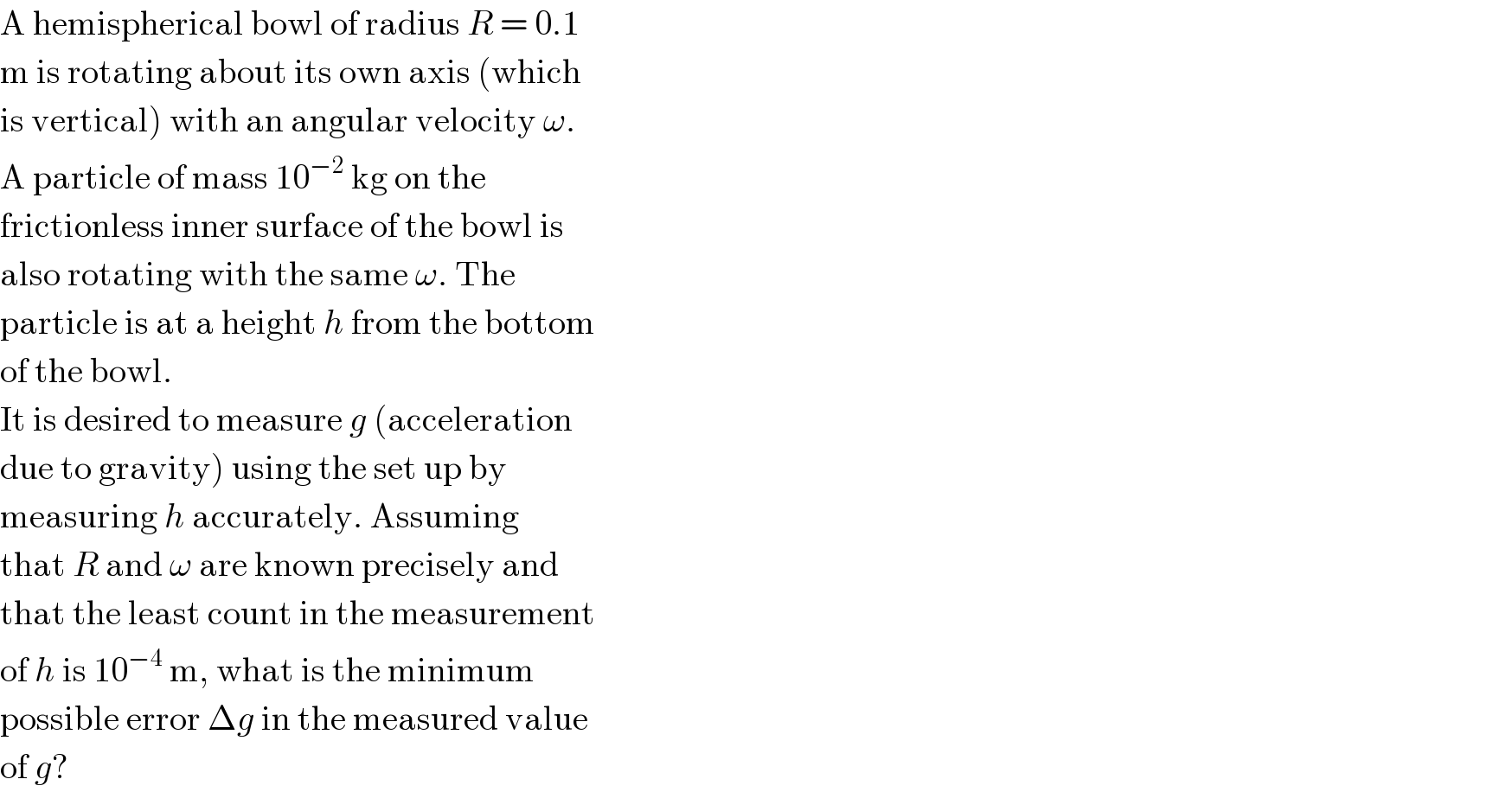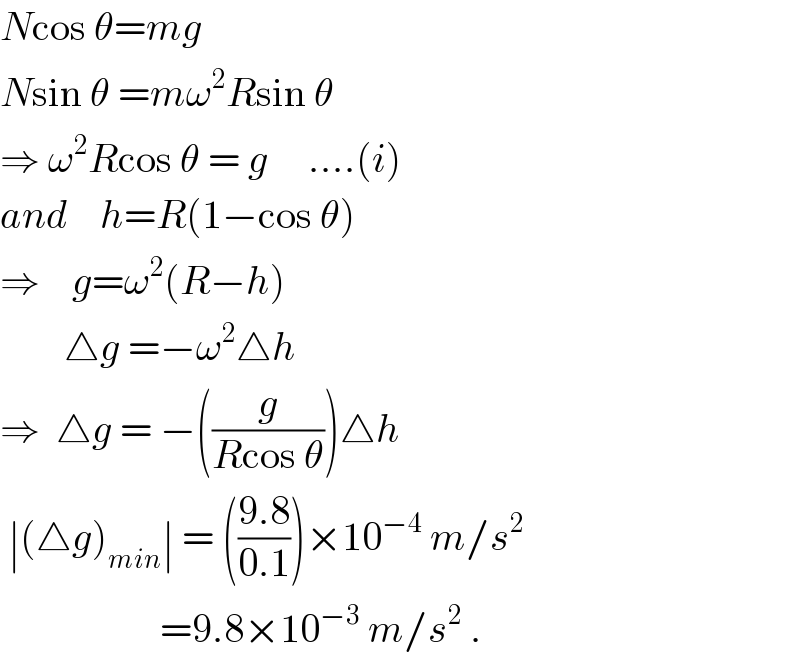
Question Number 24032 by Tinkutara last updated on 11/Nov/17

$$\mathrm{A}\:\mathrm{hemispherical}\:\mathrm{bowl}\:\mathrm{of}\:\mathrm{radius}\:{R}\:=\:\mathrm{0}.\mathrm{1} \\ $$$$\mathrm{m}\:\mathrm{is}\:\mathrm{rotating}\:\mathrm{about}\:\mathrm{its}\:\mathrm{own}\:\mathrm{axis}\:\left(\mathrm{which}\right. \\ $$$$\left.\mathrm{is}\:\mathrm{vertical}\right)\:\mathrm{with}\:\mathrm{an}\:\mathrm{angular}\:\mathrm{velocity}\:\omega. \\ $$$$\mathrm{A}\:\mathrm{particle}\:\mathrm{of}\:\mathrm{mass}\:\mathrm{10}^{−\mathrm{2}} \:\mathrm{kg}\:\mathrm{on}\:\mathrm{the} \\ $$$$\mathrm{frictionless}\:\mathrm{inner}\:\mathrm{surface}\:\mathrm{of}\:\mathrm{the}\:\mathrm{bowl}\:\mathrm{is} \\ $$$$\mathrm{also}\:\mathrm{rotating}\:\mathrm{with}\:\mathrm{the}\:\mathrm{same}\:\omega.\:\mathrm{The} \\ $$$$\mathrm{particle}\:\mathrm{is}\:\mathrm{at}\:\mathrm{a}\:\mathrm{height}\:{h}\:\mathrm{from}\:\mathrm{the}\:\mathrm{bottom} \\ $$$$\mathrm{of}\:\mathrm{the}\:\mathrm{bowl}. \\ $$$$\mathrm{It}\:\mathrm{is}\:\mathrm{desired}\:\mathrm{to}\:\mathrm{measure}\:{g}\:\left(\mathrm{acceleration}\right. \\ $$$$\left.\mathrm{due}\:\mathrm{to}\:\mathrm{gravity}\right)\:\mathrm{using}\:\mathrm{the}\:\mathrm{set}\:\mathrm{up}\:\mathrm{by} \\ $$$$\mathrm{measuring}\:{h}\:\mathrm{accurately}.\:\mathrm{Assuming} \\ $$$$\mathrm{that}\:{R}\:\mathrm{and}\:\omega\:\mathrm{are}\:\mathrm{known}\:\mathrm{precisely}\:\mathrm{and} \\ $$$$\mathrm{that}\:\mathrm{the}\:\mathrm{least}\:\mathrm{count}\:\mathrm{in}\:\mathrm{the}\:\mathrm{measurement} \\ $$$$\mathrm{of}\:{h}\:\mathrm{is}\:\mathrm{10}^{−\mathrm{4}} \:\mathrm{m},\:\mathrm{what}\:\mathrm{is}\:\mathrm{the}\:\mathrm{minimum} \\ $$$$\mathrm{possible}\:\mathrm{error}\:\Delta{g}\:\mathrm{in}\:\mathrm{the}\:\mathrm{measured}\:\mathrm{value} \\ $$$$\mathrm{of}\:{g}? \\ $$
Commented by ajfour last updated on 11/Nov/17

Commented by Tinkutara last updated on 12/Nov/17

$$\mathrm{Thank}\:\mathrm{you}\:\mathrm{very}\:\mathrm{much}\:\mathrm{Sir}! \\ $$$$\mathrm{But}\:\mathrm{why}\:−\:\mathrm{in}\:\omega^{\mathrm{2}} \Delta{h}?\:\mathrm{Errors}\:\mathrm{are}\:\mathrm{always} \\ $$$$+\:\mathrm{and}\:\mathrm{added}. \\ $$
Commented by ajfour last updated on 11/Nov/17

$${N}\mathrm{cos}\:\theta={mg} \\ $$$${N}\mathrm{sin}\:\theta\:={m}\omega^{\mathrm{2}} {R}\mathrm{sin}\:\theta \\ $$$$\Rightarrow\:\omega^{\mathrm{2}} {R}\mathrm{cos}\:\theta\:=\:{g}\:\:\:\:\:....\left({i}\right) \\ $$$${and}\:\:\:\:{h}={R}\left(\mathrm{1}−\mathrm{cos}\:\theta\right) \\ $$$$\Rightarrow\:\:\:\:{g}=\omega^{\mathrm{2}} \left({R}−{h}\right) \\ $$$$\:\:\:\:\:\:\:\:\bigtriangleup{g}\:=−\omega^{\mathrm{2}} \bigtriangleup{h} \\ $$$$\Rightarrow\:\:\bigtriangleup{g}\:=\:−\left(\frac{{g}}{{R}\mathrm{cos}\:\theta}\right)\bigtriangleup{h} \\ $$$$\:\mid\left(\bigtriangleup{g}\right)_{{min}} \mid\:=\:\left(\frac{\mathrm{9}.\mathrm{8}}{\mathrm{0}.\mathrm{1}}\right)×\mathrm{10}^{−\mathrm{4}} \:{m}/{s}^{\mathrm{2}} \\ $$$$\:\:\:\:\:\:\:\:\:\:\:\:\:\:\:\:\:\:\:\:=\mathrm{9}.\mathrm{8}×\mathrm{10}^{−\mathrm{3}} \:{m}/{s}^{\mathrm{2}} \:. \\ $$
Commented by NECx last updated on 12/Nov/17

$${when}\:{you}\:{draw}\:{with}\:{this}\:{app}\:{do}\:{you} \\ $$$${use}\:{your}\:{hand}\:{or}\:{a}\:{stylus}\:{pen}? \\ $$$$ \\ $$$${i}'{m}\:{asking}\:{because}\:{i}\:{try}\:{to}\:{use}\:{it} \\ $$$${with}\:{my}\:{hands}\:{but}\:{my}\:{drawings}\:{are} \\ $$$${not}\:{as}\:{nice}\:{as}\:{the}\:{ones}\:{i}\:{see}\:{you} \\ $$$${post}\:{here}. \\ $$
Commented by ajfour last updated on 12/Nov/17

$${dont}\:{have}\:{stylus}\:,\:{i}\:{draw}\:{with} \\ $$$${finger}\:{after}\:{necessary}\:{zoom} \\ $$$${using}\:{Handraw}. \\ $$
Commented by ajfour last updated on 12/Nov/17

$${this}\:{implies}\:{that}\:{if}\:{measured} \\ $$$${h}\:{is}\:{little}\:{greater}\:{than}\:{true} \\ $$$${value},\:{then}\:{calculated}\:{g}\:{will}\:{be} \\ $$$${less}\:{than}\:{the}\:{true}\:{value}.. \\ $$
Commented by NECx last updated on 12/Nov/17

$${ok}\:{boss} \\ $$
